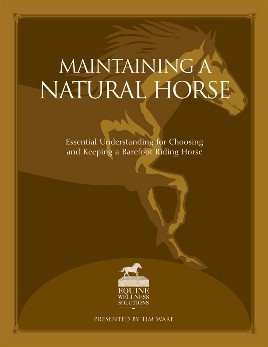I recently read a book, “Maintaining a Natural Horse”, by Tim Ware. Tim does barefoot trimming, so understands the needs completely. He presents a program for keeping a horse barefoot and rideable. A basic understanding of hoof function and the characteristics of the horse as a nautrally occurring animal is assumed. Tim also has available video selections, “Understanding the Hoof-from the Horse’s Perspective” and “Understanding the Horse-from the Horses’ Perspective”.

Throughout their history of domestication, horses have been maintaied and ridden barefoot, but in the United States, only in the past couple of decades, after studies were done of the feet of free-roaming horses in the Western states and after the theories of German veterinatian Dr. Hiltrud Strasser were widely disseminated, has the idea of barefoot horses been the subject of much discussion. The ground was fertile for a new approach to hoof care, because so many horses under the care of traditional farriery experienced hoof and lameness problems. One estimate from the farrier community itself, the percentage of horses with lameness problems was estimated to be around 90 percent. Owners who thought they were providing the best of care for thier horses’ feet nevertheless found their horses plagued with foot problems and their farriers and vets ill-equipped even to explain the causes of the problems, much less consistently to do anything about them. Personalities developed in the barefoot field and attracted a following. Claims were made about barefoot horsemanship that seemed to promise the moon but were in many cases exaggerated and too narrowly focused. Riders who tried barefoot often met with little success, as the promises did not materialize.
Tim received a call several years ago from a woman who was quite excited about the prospect of barefoot riding. Like many owners, she had been through several different farriers, wasn’t satisfied with the condition of her horse’s feet, and frankly looked forward to just ditching the shoes and not having to worry about the feet. From what she had read about barefoot, she had the impression that all she had to do was find someone who knew how to do the proper trim, and that was that. Many horse owners had understood the barefoot movements as basically making two claims. The first was that shoes are harmful to horses’ feet, and the second claim was that shoes are completely unnecessary.
The truth is that you can ride a barefoot horse, but if you do more than just light, occasional riding, you will have to make some changes in how you keep and deal with your horse. It’s something that you can make happen by employing natural horse care principles. In this book, Tim shares his ideals on how to accomplish that and explains what and why you need to make certain maintenance adjustments to your horse care/hoof care routines. He explains that hoof boots are very important in your transition and will remain so as you ride in terrain that is different from where your horse lives and spends his non-riding days.
He explains the part that nature plays in the barefoot processes; how your living arrangements for your horse affect the hooves; the role that diet and exercise play; and emotional wellness for the horse. He also has a chapter devoted to barefoot trimming.
Check out his book, “Maintaining a Natural Horse” for good reading about your role in helping your horse go natural, stay natural and enjoying barefoot for your equine partner.
Posted by Nancy Fredrick




